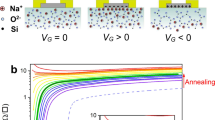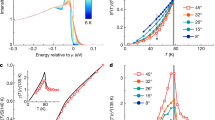Abstract
Coulomb interactions between the carriers may provide the mechanism for enhanced unconventional superconductivity in the copper oxides. However, they simultaneously cause inelastic quasiparticle scattering that can destroy it. Understanding the evolution of this balance with doping is crucial because it is responsible for the rapidly diminishing critical temperature as the hole density p is reduced towards the Mott insulating state. Here, we use tunnelling spectroscopy to measure the T→0 spectrum of electronic excitations N(E) over a wide range of hole density p in superconducting Bi2Sr2CaCu2O8+δ. We introduce a parameterization for N(E) based on a particle–hole symmetric anisotropic energy gap Δ(k)=Δ1(cos(kx)−cos(ky))/2 plus an inelastic scattering rate that varies linearly with energy Γ2(E)=α E. We demonstrate that this form of N(E) enables successful fitting of differential tunnelling conductance spectra throughout much of the Bi2Sr2CaCu2O8+δ phase diagram. We find that Δ1 values rise with falling p along the familiar trajectory of excitations to the ‘pseudogap’ energy, whereas the energy-dependent inelastic scattering rate Γ2(E)=α E seems to be an intrinsic property of the electronic structure and rises steeply for p<16%. Such diverging inelastic scattering may play a key role in suppression of superconductivity in the copper oxides as the Mott insulating state is approached.
This is a preview of subscription content, access via your institution
Access options
Subscribe to this journal
Receive 12 print issues and online access
$209.00 per year
only $17.42 per issue
Buy this article
- Purchase on Springer Link
- Instant access to full article PDF
Prices may be subject to local taxes which are calculated during checkout






Similar content being viewed by others
References
Kohsaka, Y. et al. An intrinsic bond-centered electronic glass with unidirectional domains in underdoped cuprates. Science 315, 1380–1385 (2007).
Balatsky, A. V., Vekhter, I. & Zhu, J. X. Impurity-induced states in conventional and unconventional superconductors. Rev. Mod. Phys. 78, 373–433 (2006).
Hussey, N. E. Low-energy quasiparticles in high-Tc cuprates. Adv. Phys. 51, 1685–1771 (2002).
Fischer, O., Kugler, M., Maggio-Aprile, I., Berthod, C. & Renner, C. Scanning tunneling spectroscopy of high-temperature superconductors. Rev. Mod. Phys. 79, 353–419 (2007).
Ørenstein, J. & Millis, A. J. Advances in the physics of high-temperature superconductivity. Science 288, 468–474 (2000).
Timusk, T. & Statt, B. The pseudogap in high-temperature superconductors: An experimental survey. Rep. Prog. Phys. 62, 61–122 (1999).
Huefner, S., Hossain, M. A., Damascelli, A. & Sawatzky, G. A. Two gaps make a high temperature superconductor. Preprint at <http://arxiv.org/abs/cond-mat/0706.4282> (2007).
Campuzano, J. C., Norman, M. R. & Randeria, M. The Physics of Superconductors Vol. II, 167–273 (Springer, New York, 2004).
Damascelli, A., Hussain, Z. & Shen, Z. X. Angle-resolved photoemission studies of the cuprate superconductors. Rev. Mod. Phys. 75, 473–541 (2003).
Anderson, P. W. The resonating valance bond state in La2CuO4 and superconductivity. Science 235, 1196–1198 (1987).
Zhang, F. C., Gros, C., Rice, T. M. & Shiba, H. A renormalized hamiltonian approach to a resonant valence bond wavefunction. Supercond. Sci. Technol. 1, 36–46 (1988).
Kotliar, G. A resonating valence bonds and d-wave superconductivity. Phys. Rev. B 37, 3664–3666 (1988).
Paramekanti, A., Randeria, M. & Trivedi, N. Projected wave functions and high temperature superconductivity. Phys. Rev. Lett. 87, 217002 (2001).
Anderson, P. W. et al. The physics behind high-temperature superconducting cuprates: The ‘plain vanilla’ version of RVB. J. Phys. Condens. Matter 16, R755–R769 (2004).
Chakravarty, S., Laughlin, R. B., Morr, D. K. & Nayak, C. Hidden order in the cuprates. Phys. Rev. B 63, 094503 (2001).
Varma, C. M. Non-Fermi-liquid states and pairing instability of a general model of copper oxide metals. Phys. Rev. B 55, 14554–14580 (1997).
Honerkamp, C., Fu, H. C. & Lee, D. H. Phonons and d-wave pairing in the two-dimensional Hubbard model. Phys. Rev. B 75, 014503 (2007).
Newns, D. M. & Tsuei, C. C. Fluctuating Cu–O–Cu bond model of high-temperature superconductivity. Nature Phys. 3, 184–191 (2007).
Valla, T. et al. Evidence for quantum critical behavior in the optimally doped cuprate Bi2Sr2CaCu2O8+δ . Science 285, 2110–2113 (1999).
Yamasaki, T. et al. Unmasking the nodal quasiparticle dynamics in cuprate superconductors using low-energy photoemission. Phys. Rev. B 75, 140513 (2007).
Valla, T. et al. Fine details of the nodal electronic excitations in Bi2Sr2CaCu2O8+δ . Phys. Rev. B 73, 184518 (2006).
Basov, D. N. & Timusk, T. Electrodynamics of high-Tc superconductors. Rev. Mod. Phys. 77, 721–779 (2005).
Valla, T. et al. Temperature dependent scattering rates at the Fermi surface of optimally doped Bi2Sr2CaCu2O8+δ . Phys. Rev. Lett. 85, 828–831 (2000).
Kaminski, A., Fretwell, H. M., Norman, M. R., Randeria, M. & Rosenkranz, S. Momentum anisotropy of the scattering rate in cuprate superconductors. Phys. Rev. B 71, 014517 (2005).
Gedik, N., Yang, D. S., Logvenov, G., Bozovic, I. & Zewail, A. H. Nonequilibrium phase transitions in cuprates observed by ultrafast electron crystallography. Science 316, 425–429 (2007).
Tinkham, M. Introduction to Superconductivity (McGraw-Hill, New York, 1996).
Dynes, R. C., Narayanamurti, V. & Garno, J. P. Direct measurement of quasiparticle-lifetime broadening in a strong-coupled superconductor. Phys. Rev. Lett. 41, 1509–1512 (1978).
Norman, M. R., Randeria, M., Ding, H. & Campuzano, J. C. Phenomenological models for the gap anisotropy of Bi2Sr2CaCu2O8 as measured by angle-resolved photoemission spectroscopy. Phys. Rev. B 52, 615–622 (1995).
Lang, K. M. et al. Imaging the granular structure of high-Tc superconductivity in underdoped Bi2Sr2CaCu2O8+δ . Nature 415, 412–416 (2002).
McElroy, K. et al. Coincidence of checkerboard charge order and antinodal state decoherence in strongly underdoped superconducting Bi2Sr2CaCu2O8+δ . Phys. Rev. Lett. 94, 197005 (2005).
McElroy, K. et al. Atomic-scale sources and mechanism of nanoscale electronic disorder in Bi2Sr2CaCu2O8+δ . Science 309, 1048–1052 (2005).
Gomes, K. K. et al. Visualizing pair formation on the atomic scale in the high-Tc superconductor Bi2Sr2CaCu2O8+δ . Nature 447, 569–572 (2007).
Howald, C., Fournier, P. & Kapitulnik, A. Inherent inhomogeneities in tunneling spectra of Bi2Sr2CaCu2O8−x crystals in the superconducting state. Phys. Rev. B 64, 100504 (2001).
McElroy, K. et al. Relating atomic-scale electronic phenomena to wave-like quasiparticle states in superconducting Bi2Sr2CaCu2O8+δ . Nature 422, 592–596 (2003).
Hanaguri, T. et al. Quasiparticle interference and superconducting gap in Ca2−xNaxCuO2Cl2 . Nature Phys. 3, 865–871 (2007).
Nunner, T. S., Andersen, B. M., Melikyan, A. & Hirschfeld, P. J. Dopant-modulated pair interaction in cuprate superconductors. Phys. Rev. Lett. 95, 177003 (2005).
Quinlan, S. M., Hirschfeld, P. J. & Scalapino, D. J. Infrared conductivity of a d x 2 − y 2 -wave superconductor with impurity and spin-fluctuation scattering. Phys. Rev. B 53, 8575 (1996).
Dahm, T. Anisotropy of the quasiparticle damping in the high-Tc superconductors Bi2Sr2CaCu2O8 and YBa2Cu3O6.9 as seen from angle-resolved photoemission experiments. Phys. Rev. B 54, 10150–10154 (1996).
Franz, M. & Millis, A. J. Phase fluctuations and spectral properties of underdoped cuprates. Phys. Rev. B 58, 14572–14580 (1998).
Millis, A. J. & Norman, M. Antiphase stripe order as the origin of electron pockets observed in 1/8-hole-doped cuprates. Phys. Rev. B 76, 220503(R) (2007).
Kanigel, A. et al. Evolution of the pseudogap from Fermi arcs to the nodal liquid. Nature Phys. 2, 447–451 (2006).
Tanaka, K. et al. Distinct Fermi-momentum-dependent energy gaps in deeply underdoped Bi2212. Science 314, 1910–1913 (2006).
Boyer, M. C. et al. Imaging the two gaps of the high-temperature superconductor Bi2Sr2CuO6+x . Nature Phys. 3, 802–806 (2007).
Graser, S., Hirschfeld, P. J. & Scalapino, D. J. Local quasiparticle lifetimes in a d-wave superconductor. Preprint at <http://arxiv.org/abs/cond-mat/0801.0101> (2007).
Chubukov, A. V., Norman, M. R., Millis, A. J. & Abrahams, E. Gapless pairing and the Fermi arc in the cuprates. Phys. Rev. B 76, 180501 (2007).
Acknowledgements
We acknowledge and thank D. Dessau, E. W. Hudson, P. Johnson, D. H. Lee, P. A. Lee, A. P. Mackenzie, A. Millis, M. Norman, N. P. Ong, M. Randeria, D. J. Scalapino, K. Shen, T. Timusk, Y. Uemura and T. Valla for helpful conversations and communications. This work is supported by NSF through the Cornell Center for Material Research, by the Cornell Theory Center, by Brookhaven National Laboratory under Contract No. DE-AC02-98CH1886 with the US Department of Energy, by US Department of Energy Awards DE-FG02-06ER46306 and DE-FG02-05ER46236, by the US Office of Naval Research and by Grant-in-Aid for Scientific Research from the Ministry of Science and Education (Japan) and the 21st-Century COE Program for JSPS. Fellowship support is acknowledged by K.F. from I2CAM.
Author information
Authors and Affiliations
Corresponding author
Supplementary information
Supplementary Information
Supplementary Materials and Supplementary Figures 1–4 (PDF 196 kb)
Rights and permissions
About this article
Cite this article
Alldredge, J., Lee, J., McElroy, K. et al. Evolution of the electronic excitation spectrum with strongly diminishing hole density in superconducting Bi2Sr2CaCu2O8+δ. Nature Phys 4, 319–326 (2008). https://doi.org/10.1038/nphys917
Received:
Accepted:
Published:
Issue Date:
DOI: https://doi.org/10.1038/nphys917
This article is cited by
-
Puddle formation and persistent gaps across the non-mean-field breakdown of superconductivity in overdoped (Pb,Bi)2Sr2CuO6+δ
Nature Materials (2023)
-
Investigation of Physical Properties of (Nano-SmIG)/(Bi, Pb)-2212 Phase
Journal of Low Temperature Physics (2023)
-
Property alteration of (Bi,Pb)-2212 superconductors added with graphene oxide nanoparticles
Journal of Materials Science: Materials in Electronics (2023)
-
Tailoring the Physical Properties of (Bi, Pb)-2212 Superconductor by the Addition of Cd0.95Mn0.05O Nanoparticles
Journal of Low Temperature Physics (2022)
-
Comparative Study of the Effects of La-Substituted Ca in (Bi, Pb):2212 and (Bi, Pb):2223 Superconductors
Journal of Electronic Materials (2022)



